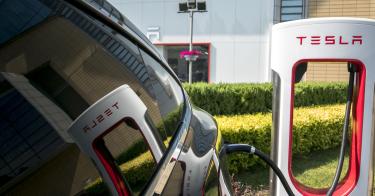Amid the economic downturn caused by COVID-19, some in Congress are calling for more stimulus programs to jump-start and sustain an economic recovery.
Many policymakers are calling for it to be done in a climate-friendly way, which has renewed interest in the Department of Energy’s Loan Programs Office.
The Loan Programs Office offers taxpayer-backed loans and loan guarantees to projects that reduce greenhouse gas emissions.
Fundamentally, however, the Department of Energy should not be an investment banker, as it distorts the risk-taking process and steers investment toward politically preferred technologies.
>>> When can America reopen? The National Coronavirus Recovery Commission, a project of The Heritage Foundation, is gathering America’s top thinkers together to figure that out. Learn more here.
There’s a chance you’ve never heard of the Energy Department’s loan guarantee program and its Advanced Technology Vehicles Manufacturing Loan Program. But you may have heard of some of the companies receiving the loans.
Solyndra received one of the first stimulus loan guarantees, a $535 million loan in September 2009. Soon after, Solyndra closed one of its facilities and canceled its initial public offering. In about two years, Solyndra filed for Chapter 11 bankruptcy and laid off all of its 1,100 workers.
A few others, like Beacon Power and the solar-power tower project Ivanpah also went belly up.
Another is Tesla. The trendy electric vehicle producer has had its financial ups and downs, but is often referenced as an example of how the program should work.
The Energy Department issued a $465 million loan in January 2010 to reopen a former plant in California for the production of Tesla’s electric vehicles and to develop a manufacturing plant to produce battery packs.
Tesla fully paid back the loan in May 2013. While even Elon Musk says the company’s stock is overvalued (Tesla has a market capitalization of $142 billion), the company appears to be performing quite well.
You may have heard of some of the other companies that received Advanced Technology Vehicles Manufacturing program loans: Nissan and Ford. Proponents point to the overall success rate of the portfolio as justification to expand it.
The reality is that both the failures and the successes illustrate why the federal government should not use taxpayer-backed loans to intervene in market investment decisions.
In some instances, the Energy Department has lent taxpayer dollars to projects that could not survive even with policies trying to prop up favored technologies.
In other instances, successful projects result from the Energy Department awarding money to very profitable, well-established companies or ones that benefit from the great number of federal, state, and local subsidies at their disposal.
Their long-term success may depend on more preferential treatment from government at all levels. And yet, some of these projects may be innovative, competitive, and turn profits. However, if that’s the case, private actors should bear all the risk.
Perhaps the biggest problem with the loan and loan guarantees is that they distort how investors allocate their money. As we’ve seen in this pandemic, Americans are very creative. There’s a seemingly endless number of entrepreneurs and innovative ideas, but the capital to finance them is not endless.
That requires that choices be made among the different investments. Through regulations and subsidies, including the loan programs, Washington distorts those investments by allocating both public and private financing to projects that have political support.
While low-risk projects will likely receive investment, others may miss out, especially if they’re not the type of project in the political limelight.
Furthermore, when the government dictates how private-sector resources are spent, both industries that stand to benefit and those that are harmed by those policy decisions will concentrate more effort on lobbying.
Businesses can use regulations and subsidies to shield them from the competition, and members of Congress can boast to their constituents that they “created jobs” for their district, when in truth the process impedes innovation in the short run and long run alike.
Rather than expand these programs, Congress should close them for good.
The Congressional Budget and Impoundment Control Act of 1974 authorizes the president to rescind funding previously enacted into law. In fact, the White House’s 2018 rescission proposal included rescinding the $4.3 billion remaining in the Advanced Technology Vehicles Manufacturing Loan Program.
Eliminating the loan programs is not about gutting programs for renewable power. In fact, companies building nuclear power plants have taken advantage of the program. Coal-fired power plants are eligible for loans for carbon capture and sequestration technologies.
Rather, rescinding the Energy Department’s loan program funds is about removing an unnecessary function of the federal government, eliminating political favoritism toward specific technologies, and relying on market forces to drive innovation forward to meet Americans’ energy needs.
This piece originally appeared in The Daily Signal




